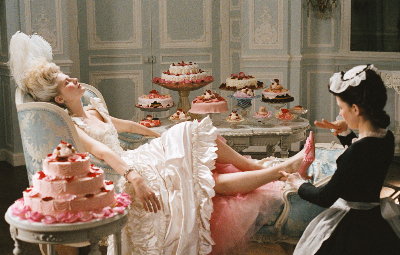
Let Them Eat Cake
I have a love/hate relationship with Marie Antionette--and all things Versaille. I am, in equal parts, fascinated and horrified by what went on there--so much so that my next novel takes place at the Court of Versaille in the time of Louis XIV. Since Sofia Coppola is, hands down, my favorite young director, I waited with breathless anticipation for the release of Marie Antoinette--a film I was sure I was going to love. Much to my surprise, when I first saw the film, I absolutely hated it. i thought it was a badly drawn pastiche, what Frederic Jameson calls "a statue with blind eyeballs." A beautiful glossy surface on which the light reflects--nothing more. But, I couldn't ignore the fact that when I sat through the film, I was starving, having no time to eat lunch, and all I could really think about was going with Willy to eat ribs after . . . (those who know me well will not be shocked by this admission).
After stuffing myself with ribs and cornbread, and reading Stephanie Zachareck's sympathetic and well-thought-out review of the film on Salon.com, I knew I had to see it again to be sure. So, i went back to the theater the following weekend, and, what can I say? This time I absolutely loved it. Coppola has a way of telling a story so quietly and unobtrusively that it is very easy to underestimate her abilities. And, of course, the film is so beautifully shot that it almost hurts to look at it--everything is styled in gorgeous pastel candy-colors of pink and blue, silver and gold. Coppola was actually the first filmmaker to be granted the privilege of shooting the film INSIDE Versaille, and to watch the characters interact in rooms I myself have stood in repeatedly, was beyond amazing. As for pastiche, if Coppola leaves Marie Antoniette herself largely undrawn, a blank for the audience to fill-in, isn't that the point? And aren't we missing Coppola's entire argument if we fail to realize this as viewers? After all, who really KNEW the REAL Marie Antoinette? She was whatever the public wanted her to be on any given day: A piece of candy, a bargaining chip, a royal womb, a traitor, a foreigner, a spendthrift, a teenager.
I don't know why Court life fascinates me the way it does--it certainly has something to do with the glorious excess of it all: the yards of satin and lace, the jewel-encrusted fans, the pavillions in the garden with billowing white sheets--complete with crystal chandeliers. The gossip. The backstabbing and cattiness--a society based on the ability to be witty, to impress your dinner guests. Many critics have pointed out that MA is one of the last political films to come along in a decade--but I don't think politics is at all Coppola's point. Coppola makes films about girls who are trying desperately to become women, thrown into often isolated worlds they cannot control. In Marie Antoinette's case, that world was created long before she arrived onto the scene--and she had little hopes of changing it once she became Queen. She was Austrian--a foreigner--and therefore, not to be trusted. Her royal status did absolutely nothing to change that.
If anything, Coppola's film makes us see that things aren't so diferent now. The lifestyles of the elite few are still glorified and celebrated as they live in their mansions, yelling at their servants--while the (mostly silent) majority cluster around the grounds, begging for bread. Too bad we don't get some torches and start a revolution--but then again, the French have always been more politically subversive--which perhaps explains why this film was booed at Cannes--its an extremely AMERICAN take on Versaille--one that embraces our oldest American pastime--the rampant buying, selling, and consuming of goods.
No comments:
Post a Comment